California is home to a diverse array of wildlife, and among its impressive avian residents are various species of hawks. These majestic birds of prey play a crucial role in maintaining ecological balance by controlling populations of rodents and other small mammals.
California, often associated with its iconic beaches and Hollywood glamour, is also a haven for many bird species, particularly hawks. Nestled within the oak woodlands, grasslands, and even urban neighborhoods, these majestic birds of prey contribute to the rich tapestry of California’s wildlife.
Beyond the palm trees and sunny beaches, California reveals its vast landscapes, encompassing deserts, mountains, and dense forests. Amidst this varied terrain thrives a diverse range of wildlife, including an array of birds of prey. Hawks, belonging to the family Accipitridae, are among the notable inhabitants, captivating observers with their aerial prowess and keen predatory instincts.
Hawks, as formidable birds of prey, often elicit admiration for their commanding presence in the skies. Belonging to the family Accipitridae, they include not only those with ‘hawk’ in their name but also birds like buzzards. While the term ‘hawk’ is commonly used, it sometimes encompasses species like the Peregrine Falcon, referred to as a sparrowhawk. Historically esteemed for their intelligence, hawks have played pivotal roles, with falconry, formerly known as hawking, showcasing their utility in hunting and conservation efforts.
California’s vastness extends beyond its size; it encompasses an impressive array of habitats, each hosting unique flora and fauna. In this tapestry, hawks play a crucial role as apex predators, maintaining ecological balance. The state’s varied landscapes, from the coastal beaches to the towering mountains, provide suitable homes for eleven distinct hawk species, each contributing to the intricate web of life.
While hawks claim their place in California’s skies, other remarkable bird species contribute to the state’s biodiversity. Among them, the Leatherback Sea Turtle and the California Condor stand out. Although the California Condor isn’t a hawk, its story of recovery serves as an inspiring testament to conservation efforts. California’s commitment to preserving its native wildlife is reflected in its diverse array of hawks and other captivating creatures.
For those passionate about birding, California offers a rewarding experience. This guide aims to enhance your understanding of the eleven hawk species that call California home. Whether you’re driving through oak woodlands, hiking in grasslands, or observing from an urban vantage point, this guide provides insights into identifying these magnificent birds of prey. Embrace the opportunity to delve into the world of California’s hawks, appreciating their significance in the state’s vibrant ecosystems.
19 Types of hawks in Texas
Types of hawks in California
Red-Tailed Hawk
The Red-tailed Hawk, a prominent raptor in California, is a large and adaptable species found year-round on the edges of forests, open woodlands, and urban areas. Identification is facilitated by its impressive size, reddish-brown tails, and distinctive raspy screech. When seeking these majestic birds, observe them perched on high trees or soaring above roadsides, utilizing the wind for efficient hunting.

Appearance
Appearance-wise, Red-tailed Hawks are hefty, with broad wings and tails, showcasing warm red coloration on the upper feathers. Notably, variations in color morphs can be observed, adding to their uniqueness. In flight, the pale area near the tips of their wings is a distinguishing feature. These birds are adaptable to diverse habitats, from backcountry to urban spaces, making them a common sight throughout California.
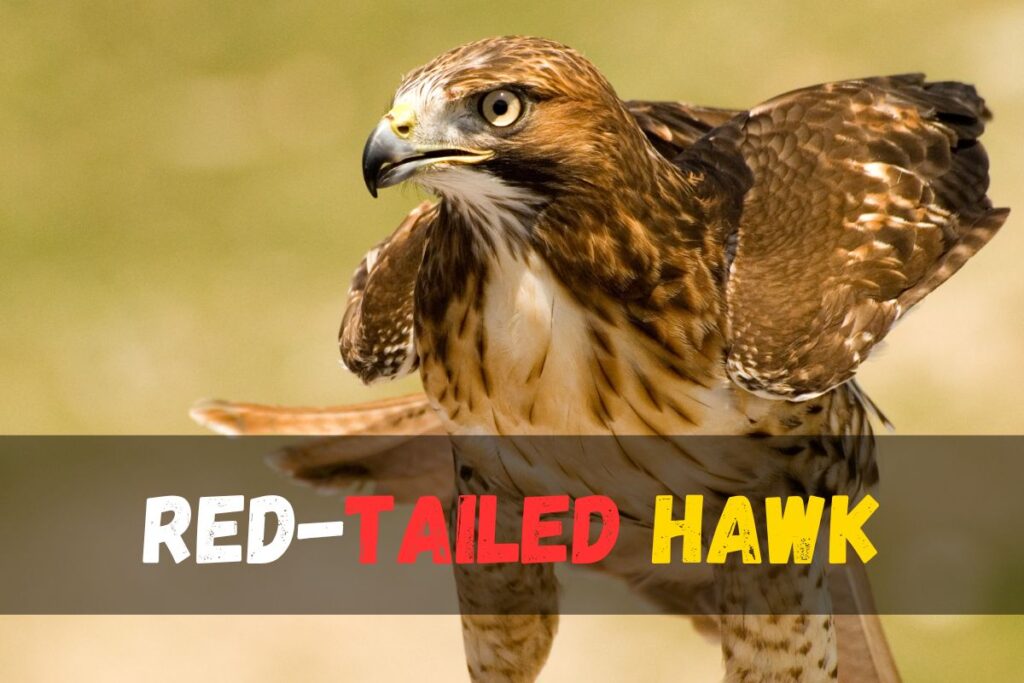
Habitat
In terms of habitat, Red-tailed Hawks exhibit versatility, thriving in pastures, parks, deserts, rainforests, and more. Their nesting habits involve building messy stick nests high in trees, demonstrating a preference for elevated locations. California’s landscape, from the coastline to the desert, provides ample opportunities to spot these hawks, showcasing their widespread presence.
Dietary habits
The dietary habits of Red-tailed Hawks encompass a variety of small animals, including squirrels, rats, snakes, and birds. Their hunting strategy involves swooping down from perches or soaring flights, showcasing their prowess as skilled hunters. The ability to adapt to different environments contributes to their success in locating prey.
population
As for population dynamics, the Red-tailed Hawk holds the title of the most common hawk species in North America. Their ability to thrive in diverse habitats, coupled with efficient hunting skills, has contributed to their widespread distribution. This adaptability is further evidenced by sightings ranging from Yellowstone National Park to suburban backyards in California.
Red-Shouldered Hawk
Red-shouldered hawks are a fascinating species of hawks found in California, particularly along the western coast. These medium-sized buteos are easily identifiable by their distinctive features. Their wings are checkered with splotches of dark brown and white, and their undersides showcase beautiful red and white barring, creating a striking appearance.
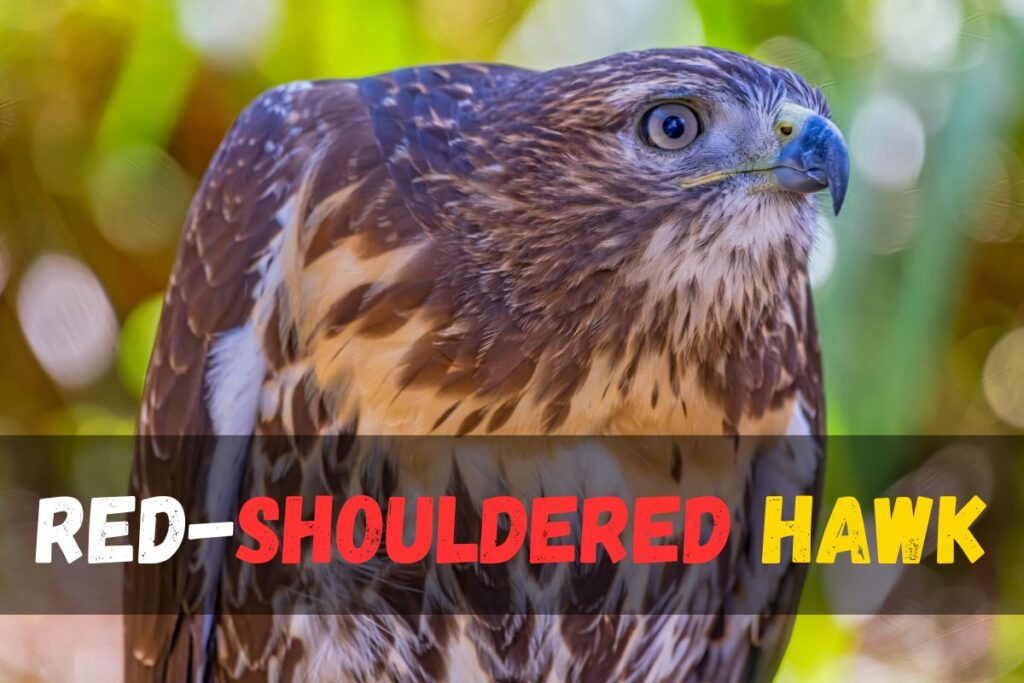
Identification:
One key identification feature of Red-Shouldered Hawks is the characteristic rust color that descends from their shoulders across their chest and belly. Despite occasional confusion with the Red-tailed Hawk, Red-Shouldered Hawks are more slender and agile, lacking the Red-tail’s pale underside.
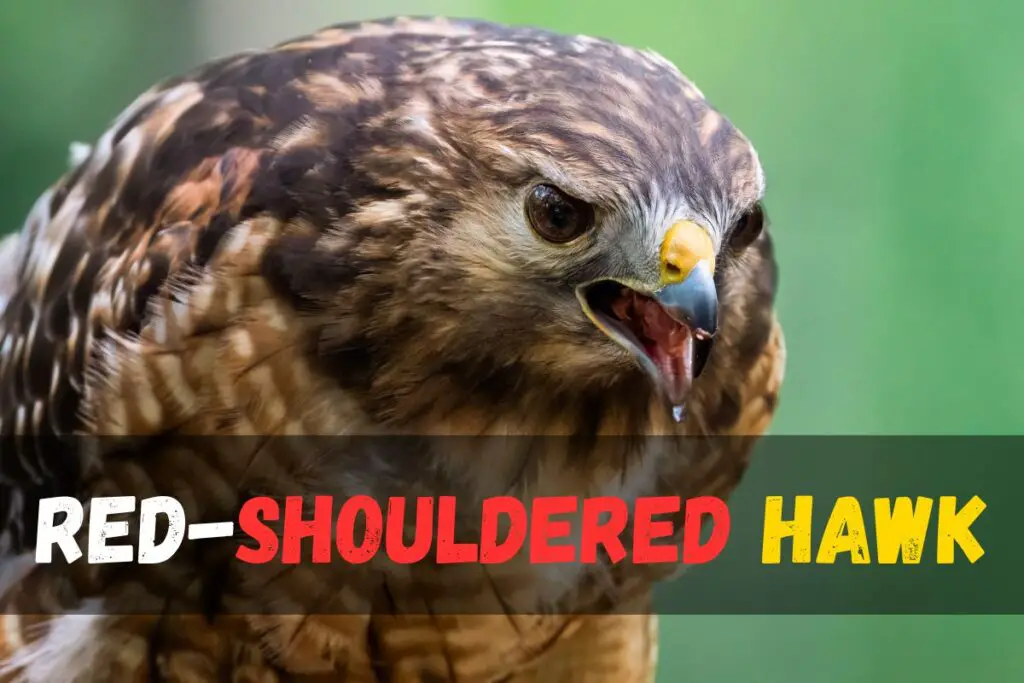
Where to Look for Them:
Red-shouldered hawks prefer habitats with an open upper canopy, making forested areas with this feature ideal for spotting them. They are commonly found in riparian woodlands, eucalyptus groves, and oak woodlands. Additionally, they are known to venture into residential areas, especially where bird feeders attract songbirds, providing an easy hunting ground.
Appearance:
These hawks have a wingspan ranging from 37.0 to 43.7 inches, and they weigh between 17.1 and 27.3 ounces. Their distinct silhouette, marked by checkered wings and the characteristic rust color, makes them stand out. In flight, observers can notice narrow, translucent crescents near the tips of their wings.
Habitat:
Unlike their Red-tailed counterparts, Red-Shouldered Hawks are primarily forest dwellers. They thrive in areas with an open upper canopy, which allows them to hunt more efficiently. This preference extends to suburban areas where houses blend into woodlands.
Diet:
Red-shouldered hawks play a crucial role in natural pest control, primarily feeding on small rodents like squirrels. They are also known to consume small mammals, lizards, snakes, and birds. Their hunting strategy involves perching on trees or poles, scanning the ground for prey before swooping down to catch it.
Population:
The Red-Shouldered Hawk is a common sight along the coast of California, contributing to one of North America’s most plentiful species of hawks. They are favored by farmers and homeowners for their role in controlling pests, although they may face displacement by the more aggressive Red-tailed hawks.
Cooper’s Hawk
Identification:
Cooper’s Hawks, prevalent year-round in California, are distinctive medium-sized raptors. Adults are recognized by their blue-gray upper parts, orange barring below, and a remarkably long, rounded tail. While males are smaller, females exhibit a dark cap, pale grayish face, and side of the neck, along with dark banding on their tails.
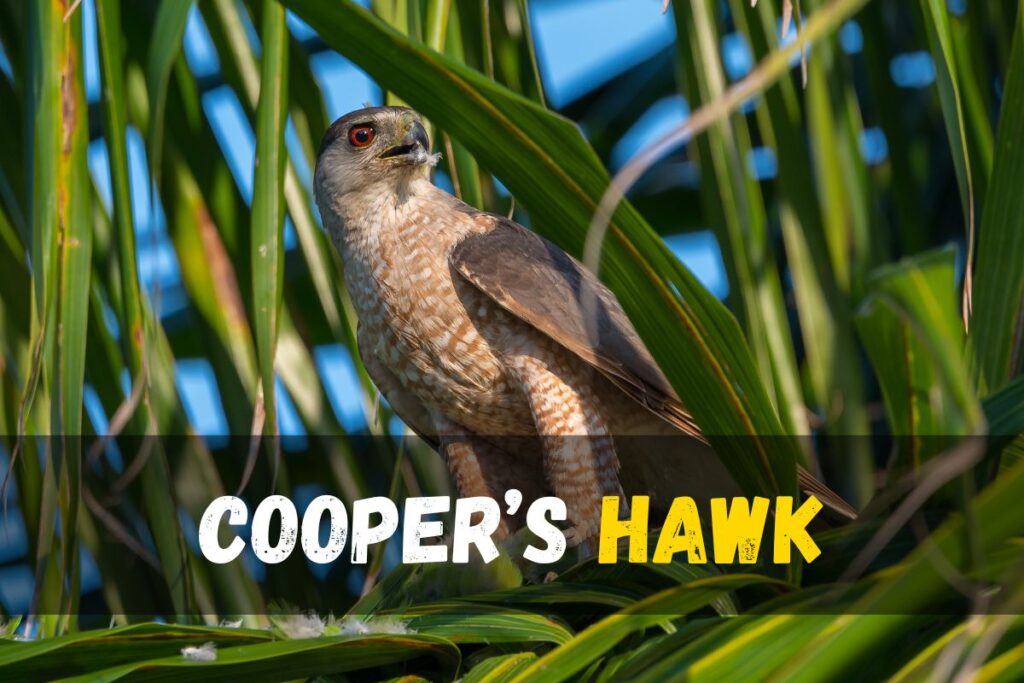
Where to Look for Them:
These hawks are commonly found in various habitats, including temperate deciduous forests, woodlands, and even towns. They display adaptability to human presence, often perching on utility poles and along roadsides. While they are migratory, some Cooper’s Hawks remain in specific parts of California throughout the year.
Appearance:
With a fair size, Cooper’s Hawks have a wingspan ranging from 24.4 to 35.4 inches and a weight of 7.8 to 24.0 ounces. Their striking blue-gray and orangey plumage, coupled with a unique tail pattern, make them easily identifiable. Notably, females are larger than males.
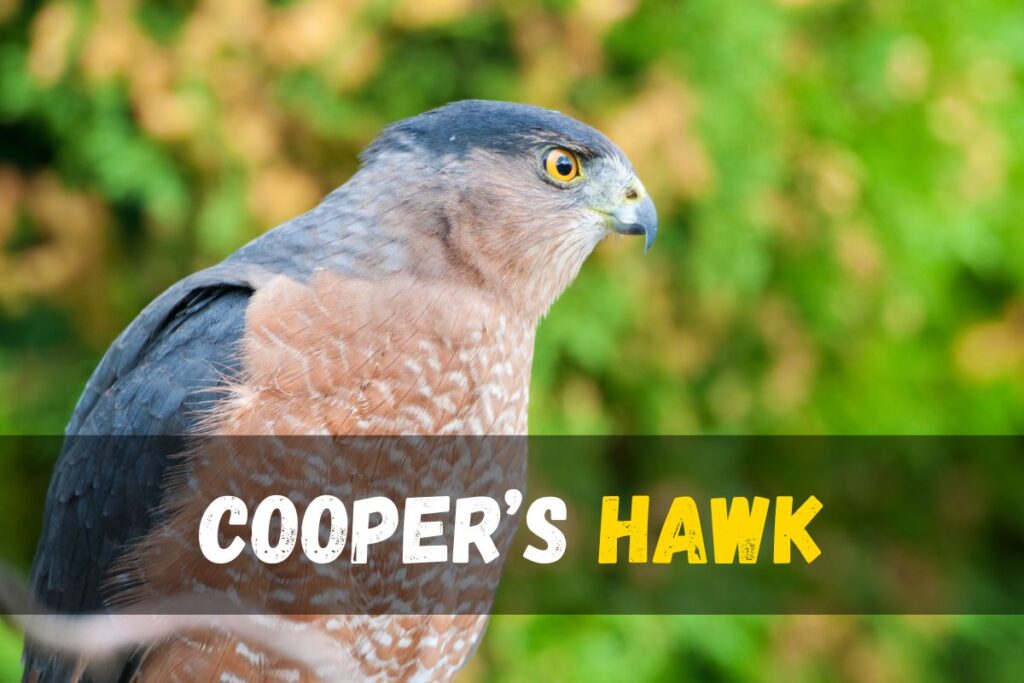
Habitat:
These raptors exhibit versatility in their habitat choices, inhabiting temperate deciduous forests, woodlands, and towns. They are not significantly affected by habitat fragmentation and can be observed in both natural and semi-urban settings.
Diet:
Cooper’s Hawks are skilled hunters preying on a variety of birds and small mammals. Their diet includes band-tailed pigeons, rock doves, common grackles, squirrels, and medium-sized birds like doves. They are known for their adept flying abilities, chasing prey through the air or vegetation.
Population:
After facing declines due to the pesticide DDT in the 1950s and 60s, Cooper’s Hawk populations have rebounded. They are now a common sight in California. Their adaptability to diverse environments and successful recovery make them a notable success story in bird conservation.
Swainson’s Hawk
Swainson’s Hawks are a distinctive species of hawk found in California, particularly during their breeding season. These birds, scientifically known as Buteo swainsoni, have a notable size, with a length ranging from 17 to 22 inches and a weight of 1.1 to 3.7 pounds. Their wingspan extends from 46 to 54 inches, and they have a lifespan of 8 to 14 years, currently categorized as of “Least Concern” in terms of conservation status.
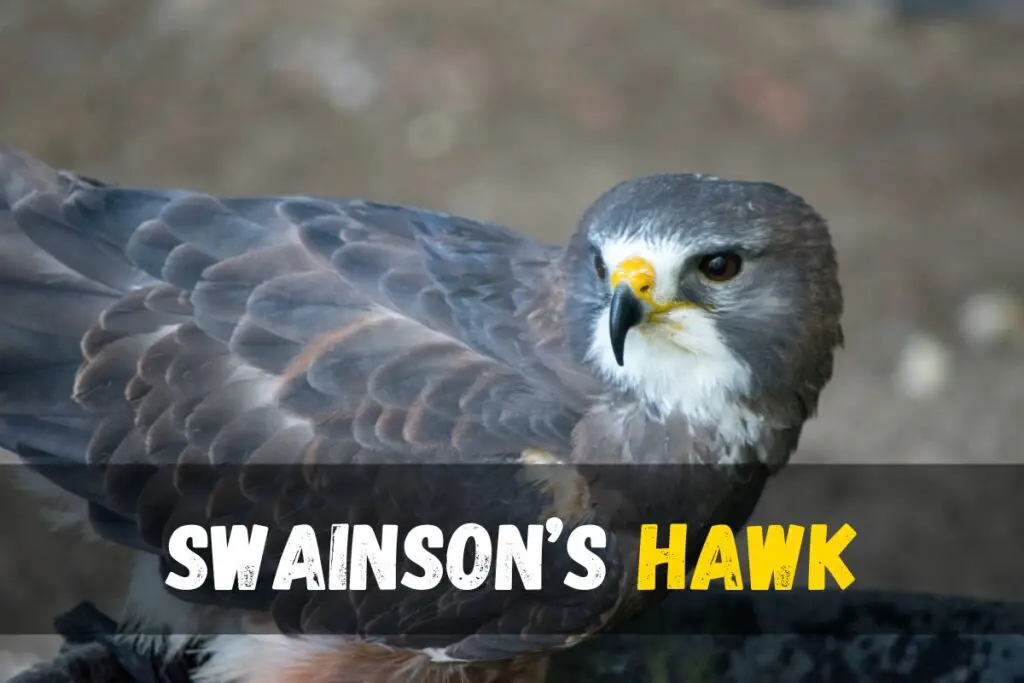
Identification:
These hawks are easily identified by their large, long-winged build, featuring dark flight feathers and a broad tail with fine dark banding and a dark tip. Males and females are similar in appearance, with color variations, typically gray or brown on the upper parts of their wings and dark or reddish-brown underneath. Adults may have white or reddish-brown markings on their underparts.
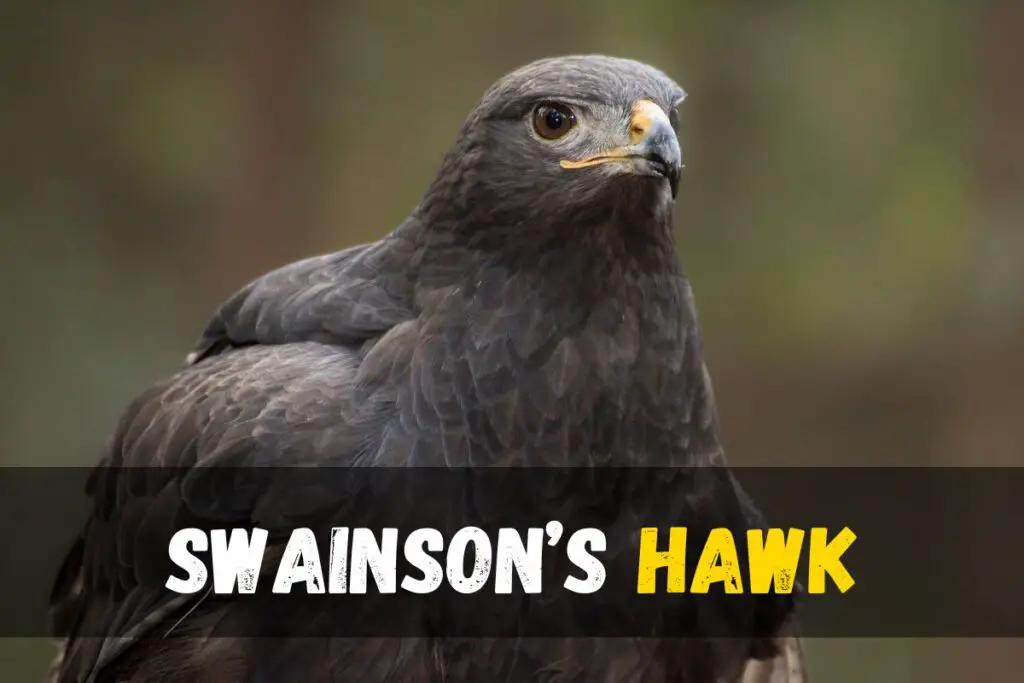
Where to Look for Them:
Swainson’s Hawks prefer open, dry habitats such as prairies, pastures, and even deserts. During the breeding season, they can be spotted in the grasslands and prairies of California. Nesting sites are often in secluded trees and shrubs, though they may also inhabit cliffs or steep slopes for a clear vantage point while hunting.
Appearance:
While they share characteristics with other buteos like Red-tailed and Red-shouldered Hawks, Swainson’s Hawks are slimmer with longer wings. The key identification features include dark-brown upperparts with pale-colored undersides, distinct coloration on the underwings with bright white plumage toward the body, and contrasting black feathers near the edges. Males typically have gray heads, and females have brown heads.
Habitat:
These hawks are adaptable to various open environments, including grasslands, plains, and pastures. They build bulky stick nests in trees and are known to migrate over long distances, traveling from western North America to the grasslands in Argentina.
Diet:
Swainson’s Hawks play a crucial role in pest control for farmers, earning them names like grasshopper hawk or locust hawk. They primarily feed on large insects such as caterpillars and grasshoppers but also target small birds, pocket gophers, ground squirrels, snakes, mice, and occasionally carrion or bats. During the breeding season, their diet is predominantly insects.
Population:
While their populations have faced declines in California, particularly outside the breeding season, Swainson’s Hawks are still regularly observed in the state during their summer stay. Their migration spans around 6,000 miles to Argentina, making it a remarkable feat that occurs twice a year. They are skilled hunters of ground squirrels, which are common in their preferred dry habitats.
Rough-legged Hawk
The Rough-legged Hawk, scientifically known as Buteo lagopus, is a notable member of the raptor family Accipitridae, native to North and Central America. In California, although relatively rare, these majestic hawks can be found in the northern and eastern regions of the state during winter.

Identification:
Distinguished by its medium size, long wings, and feathered legs, the Rough-legged Hawk exhibits two color morphs. Pale individuals are characterized by pale gray-brown tones, while dark ones showcase a predominantly dark brown hue. Both morphs share broad white patches near their dark wing tips and a longish pale tail with a broad black tip.
Where to Look for Them:
To observe Rough-legged Hawks in California, one should focus on the northern and eastern border areas during the winter months. These hawks are known for hovering over marshes, and open fields, or perching on poles, showcasing their impressive aerial displays.
Appearance:
With a wingspan ranging from 52.0 to 54.3 inches and a length of 18.5-20.5 inches, the Rough-legged Hawk falls between the size of a crow and a goose. Their distinctive features include a long-winged structure, a black and white tail, and broad white patches near the tips of their wings.
Habitat:
While breeding in Alaska and northern Canada, Rough-legged Hawks migrate to the US, including California, for winter. These hawks prefer open fields and marshes, where they build bulky nests on cliffs or rocky outcroppings.
Diet:
Rough-legged Hawks are skilled hunters, preying on a variety of animals such as rodents, birds, reptiles, and insects. In California, voles, mice, ground squirrels, and other small mammals serve as their primary winter prey.
Population:
Though considered widespread in their overall range, the population of Rough-legged Hawks in California is relatively sparse. Their presence is more pronounced in the northern and eastern parts of the state during the winter season.
Ferruginous Hawk
Ferruginous Hawks, scientifically known as Buteo regalis, are magnificent raptors that inhabit the open deserts and prairies of California. Being the largest North American hawks, they are easily identifiable by specific characteristics and behaviors.

Identification Traits:
Ferruginous Hawks exhibit two distinct color morphs. Light morph individuals have a rusty-brown back and pale underparts, while dark morphs are characterized by dark brown and chestnut-colored plumage on their back, chest, and belly. These hawks are large with long wings, a wide gray, rusty, or white tail, and feathered legs. Adults can be white below with red-brown on their wing linings and flanks, and juveniles are paler below.

In flight, Ferruginous Hawks soar with wings held in a shallow “V”. Pale primary patches are visible on the upper sides of each wing. This flight trajectory, coupled with their unique vocalization—a raspy, descending “reeaaaauh!” – aids in their identification.
Where to Look for Them:
Ferruginous Hawks are primarily found in wide open habitats, including south-central Canada, the western USA, and northern Mexico. In California, particularly during winter, these hawks inhabit farmlands, open fields, prairies, and deserts. They are often perched up high or soaring above, displaying their characteristic flight pattern.
Ferruginous Hawks are common in California, they can be challenging to spot outside the winter months. The plains and grasslands offer better chances for observation. Look for isolated trees, rock outcroppings, or other structures where they might build their large, bulky stick nests.
Appearance and Habitat:
The Ferruginous Hawk is eagle-like, with reddish-brown and gray upperparts. The name “Ferruginous” refers to the rust-colored plumage on their backs and legs. The larger size, long broad wings, and distinctive color morphs contribute to their unique appearance.
These hawks build substantial stick nests in lone trees or on rock outcroppings. The nests are used for incubating eggs, with females laying around three to five eggs. Both parents take turns incubating, and after hatching, the males provide food for the females and nestlings.
Diet and Population:
Ferruginous Hawks are versatile predators, preying on prairie dogs, mammals, waterfowl, rats, kangaroo rats, pocket gophers, cottontails, ground squirrels, jackrabbits, large insects, snakes, and other small birds. They showcase a hunting style that involves watching from a perch or the sky and often hunting on the ground.
Unfortunately, the population of Ferruginous Hawks is threatened, with a current estimate of less than 4,000 pairs, according to Audubon. Their decline is a concern, emphasizing the need for conservation efforts. Despite the challenges, non-breeding Ferruginous Hawks can still be found during winter in California, especially in open lands like prairies, plains, and grasslands.
Northern Harrier
Identification:
The Northern Harrier, a distinctive long-winged and long-tailed hawk, is easily recognizable by its unique characteristics. With a slender body, long wings, and a white rump, these hawks are known for their V-shaped flight pattern. Their flat faces and owl-like appearance, coupled with a sharply hooked bill, set them apart from other hawks. Notably, both male and female Northern Harriers exhibit distinctive coloration, aiding in their identification.
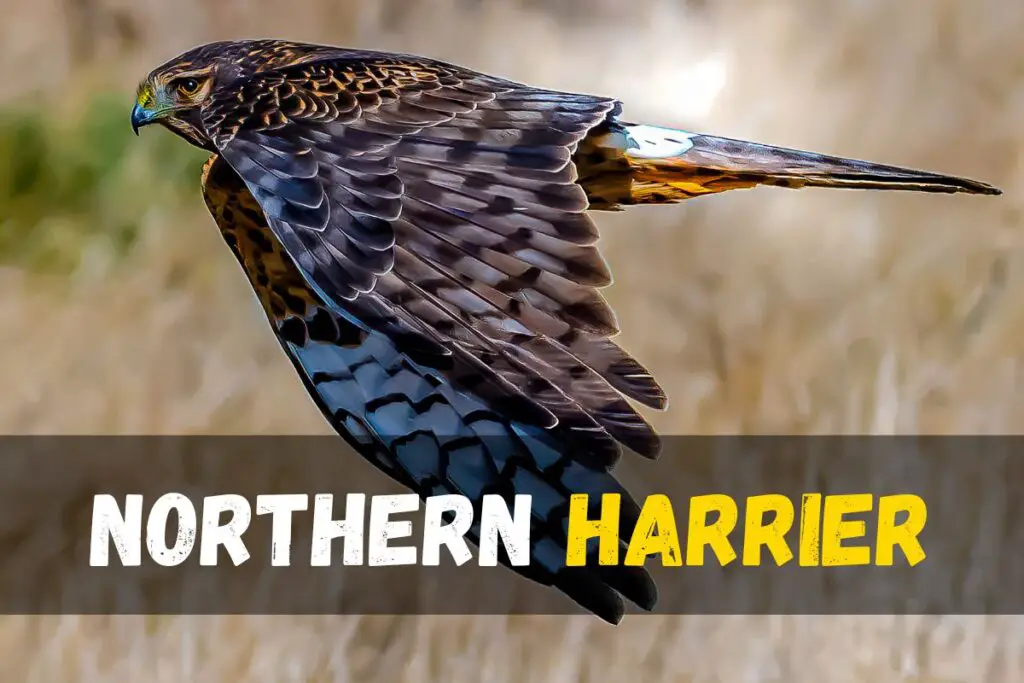
Where to Look for Them:
California provides a year-round habitat for Northern Harriers, making it an ideal location for bird enthusiasts. These hawks are commonly found in open grasslands, fields, prairie grasslands, and marshes. Observing their low gliding flight pattern, especially in pursuit of rodents like mice and voles, enhances the chances of spotting these unique birds. Their preference for wide-open spaces, including Arctic tundra, adds to the diversity of environments where they can be encountered.
Appearance:
Distinguishing between male and female Northern Harriers is key to proper identification. Females exhibit a brown upper body with white undersides and brown streaking, while males are characterized by gray upperparts and white undersides. Both genders share black banding on the tail, contributing to their identifiable features. Additionally, these hawks have a white patch on their rears, aiding in recognition during flight.
Habitat:
Northern Harriers exhibit a versatile habitat range, breeding in grasslands and open areas across Alaska, Canada, California, and the northern and central USA. Their ability to adapt to diverse environments, including thick wetlands and grasslands, is a testament to their resilience. Grass and vegetation are utilized to construct shallow nests on the ground, emphasizing their preference for specific nesting conditions.
Diet:
Specialized hunters, Northern Harriers primarily prey on small animals, capturing them on the ground. Their hovering technique before striking and the use of grass and vegetation for nesting align with their distinctive hunting style. Medium-sized birds and small mammals form the core of their diet, showcasing their role in controlling rodent populations in their habitats.
Population:
The Northern Harrier is a unique species and the sole harrier species in North America. Their presence is notable in California, where non-breeding populations are distributed widely. Understanding their population dynamics, especially in the context of their breeding grounds in Alaska, Canada, and the northern and central USA provides insight into the broader conservation considerations for these remarkable hawks.
Northern Goshawk
Identification:
Northern Goshawks (scientific name: Falco columbarius) are large, elusive hawks found in California. They are identified by their distinctive gray crowns, backs, and barrings, with red eyes and a white eyebrow. These hefty birds have a banded tail and rounded wings, with females being 25% larger than males. Young birds have dark brown, streaked plumage.

Where to Look for Them:
In California, particularly in the northern regions, one can spot Northern Goshawks year-round. They prefer large, dense forests, especially coniferous habitats. Their secretive nature makes them challenging to find, and they are often mistaken for Cooper’s Hawks.
Appearance:
Northern Goshawks exhibit a graceful yet powerful appearance. With their gray plumage and banded tails, they are the largest accipiter hawks. Their heads are dark gray with distinctive white stripes over red-orange eyes, giving them the appearance of having eyebrows. In flight, they display agile maneuvers, aided by a relatively long tail.
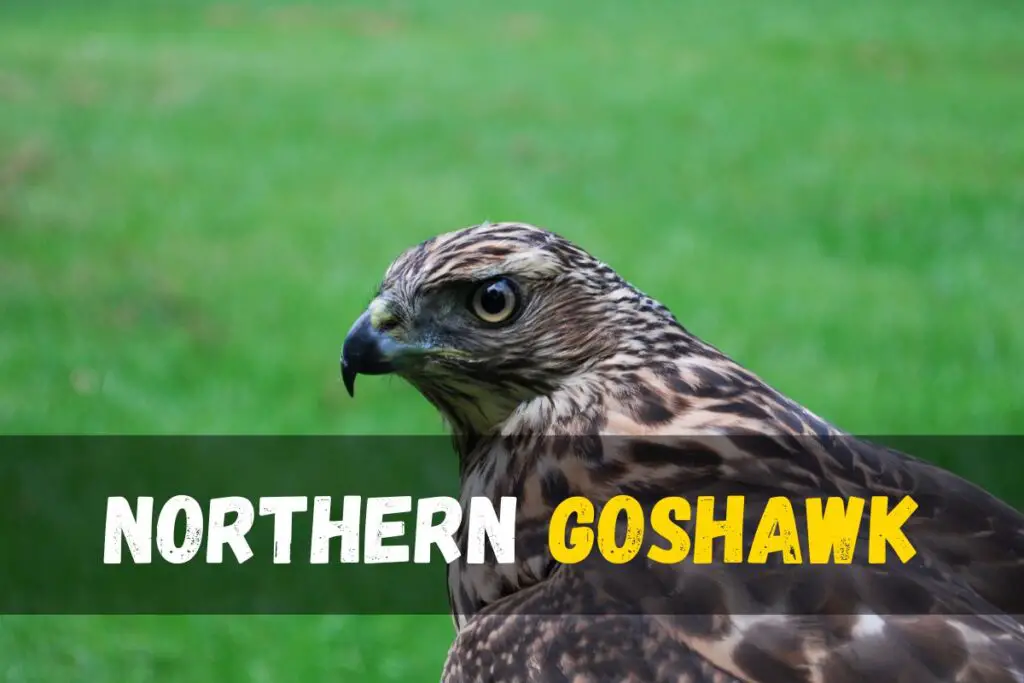
Habitat:
These hawks inhabit coniferous and other wooded habitats, not only in California but also in Alaska, Canada, parts of the northern and western USA, and northern Mexico. They build stick nests high in trees, showcasing their preference for elevated locations.
Diet:
Northern Goshawks are formidable predators, preying on snowshoe hares, rabbits, squirrels, crows, and various small birds and mammals. They are skilled hunters, using high vantage points to ambush prey. The hunting process is quick, usually lasting no more than 15 minutes.
Population:
The population of Northern Goshawks is of Least Concern according to their conservation status. They are, however, highly territorial and prefer a solitary lifestyle, except when part of a pair with their mate. Their population is observed in coniferous forests, though they may also be found in deciduous hardwood forests.
Sharp-Shinned Hawk
Sharp-shinned Hawks (Accipiter striatus) are the smallest accipiters and the tiniest hawks in California. Identifying them requires attention to specific characteristics, and despite similarities with Cooper’s Hawks, there are distinctive features.

Distinctive Features:
Sharp-shinned Hawks are recognized by their small size, rounded wings, and a long, rectangular tail. The adults exhibit blue-gray upperparts, orange barring on the underparts, and dark bands on the tail. Females, larger than males, have a dark brown above with thick streaks on pale underparts.
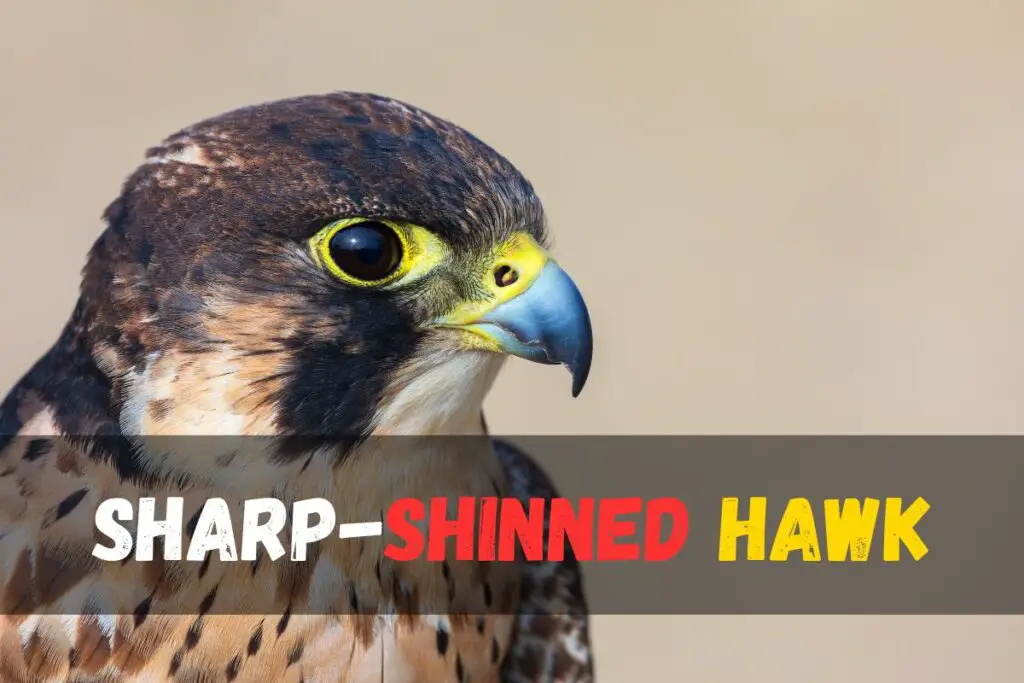
Where to Look for Them:
These hawks inhabit wooded areas across California, showcasing their agility by swiftly navigating through forests. Observing them near bird feeders or in the woods is common, especially during the winter when non-breeding populations are prevalent.
Appearance:
Despite their small size, Sharp-shinned Hawks possess a significant presence. Their wings, relatively short and rounded, complement a long, rectangular tail. Notably, the orange barring on the upper chest fading towards the belly and the blue-gray back and wings aid in quick visual identification.
Habitat:
Sharp-shinned Hawks are adaptable, residing in wooded habitats spanning Alaska, Canada, the USA, Mexico, Central America, the Caribbean, and parts of South America. They construct bulky stick nests high in conifers, showcasing a preference for elevated locations.
Diet:
The primary diet of Sharp-shinned Hawks consists of small birds, including sparrows, warblers, and vireos. Their hunting technique involves quick flights and catches within vegetation. Bird feeders often become a target, as these hawks take advantage of unsuspecting gatherings of small birds.
Population:
The population of Sharp-shinned Hawks is distributed widely, with non-breeding populations prevalent in California during winters. Their adaptability to various wooded habitats contributes to their diverse range across the Americas. Currently, their conservation status is classified as “Least Concern,” indicating a stable population.
Behavior and Vocalization:
Despite their small size, Sharp-shinned Hawks exhibit an energetic and acrobatic demeanor. While generally quiet, they make distinctive falcon-like, repeated ringing calls, especially on breeding grounds.
Gray Hawk
Identification
The Gray Hawk (Buteo plagiatus) is a distinctive medium-sized raptor, resembling the size of a crow. Distinguished by its gray feathers, this bird displays a distinctive black and white tail, gray barring underneath, and emits a distinctive descending call that goes, “Keeeear!”. It is known to prey on reptiles and other small animals in arid and subtropical habitats.
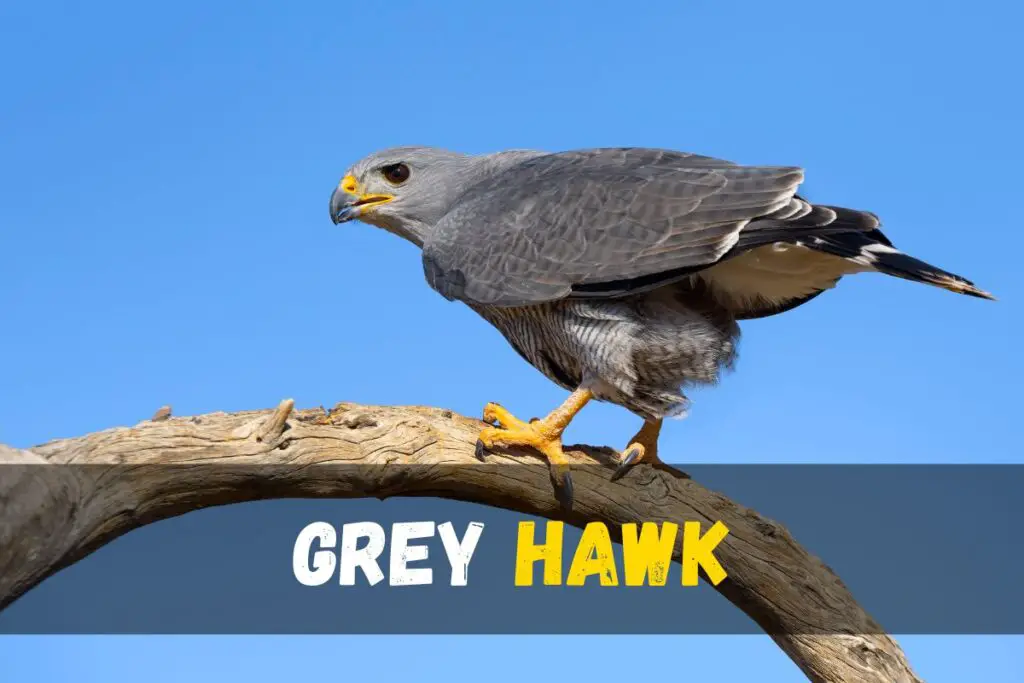
Where to Look for Them
If you’re interested in spotting Gray Hawks in California, focus your search on areas with cottonwood and willow woods, particularly near streams or rivers. These hawks can often be observed soaring over open areas or patiently perched on branches. Look for them in riparian zones and subtropical habitats.
Appearance
Adult Gray Hawks are predominantly gray with gray barring below and a distinct black and white tail. Juveniles, on the other hand, are dark brown with unique markings, including a black and yellow beak, a white face with dark marks around the eyes, and dark streaks on white underparts. In flight, they use medium-length wings for soaring, occasionally making deep flaps between glides.
Habitat
Gray Hawks inhabit various environments, including forest edges, savannahs, woodlands, and riparian zones. During breeding seasons, they nest in cottonwoods, building messy stick nests high in trees. Their preference for open country and the edges of forests makes them adaptable to different landscapes.
Diet
The diet of Gray Hawks consists of lizards, small birds, and other small animals. They display impressive hunting skills, capturing prey on the ground or from vegetation after a quick and brief chase. This species plays a crucial role in controlling the population of small mammals and maintaining ecological balance.
Population
The Gray Hawk is a tropical species, residing in southeastern Arizona and parts of southern Texas, extending southward to Costa Rica. They are known to migrate, spending the summer breeding season in Central America, Mexico, Southern Texas, and Arizona. While the exact population is challenging to estimate, their adaptability to various habitats suggests a stable presence in suitable environments.
Harris’s Hawk
Identification
Harris’s Hawks, scientifically known as Parabuteo unicinctus, are striking birds native to the southwest United States. They are easily recognizable due to their large size, ranging from 18 to 24 inches in length, and their distinctive dark brown and reddish-brown plumage. These hawks have a remarkable feature in their long black and white tails, making them stand out in their habitat. Notably, both males and females look alike, with females being slightly larger.
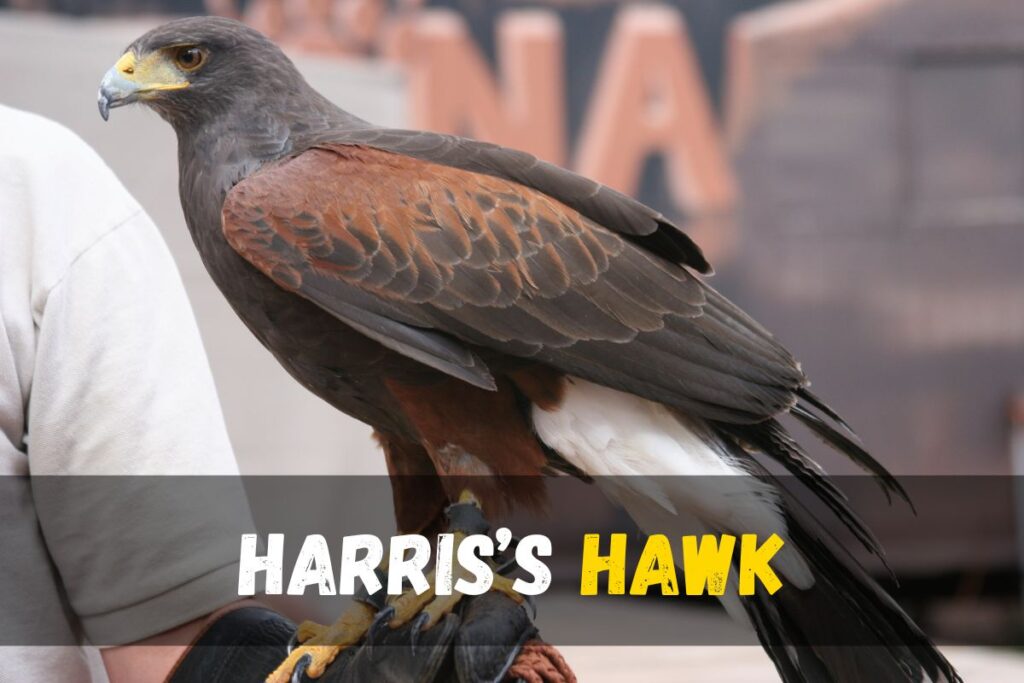
Where to Look for Them:
If you’re keen on observing Harris’s Hawks in California, head to various habitats such as woodlands and semi-desert areas. These birds are not migratory, offering year-round opportunities for bird enthusiasts to witness their fascinating behaviors. Keep an eye on desert lowlands, urban, and suburban regions as Harris’s Hawks are known to frequent these areas in search of food and water.
Appearance:
The striking appearance of Harris’s Hawks includes dark brown and reddish-brown feathers, accentuated by bright-colored shoulders. Their wingspan ranges from 36 to 48 inches, and their vocalizations, described as rather high-pitched calls like “kleeah, klee, klee, klee, klee,” add to their allure. Interestingly, despite their formidable hunting prowess, Harris’s Hawks display a social nature, often seen hunting in small groups or ‘packs.’
Habitat:
Harris’s Hawks exhibit adaptability in their choice of dwellings. While they can be found in various habitats, including woodlands and semi-desert regions, they particularly favor large cacti and trees for building their nests. These nests, constructed from bulky sticks, showcase their resourcefulness in using sturdy structures.
Diet:
These hawks have a diverse diet, preying on medium-sized mammals, reptiles, and birds. Their cooperative hunting strategies, especially when targeting rabbits and other small animals, make them stand out among other raptor species. The menu includes lizards, ground squirrels, rabbits, hares, quails, and other medium-sized birds. Additionally, they play a crucial role in the ecosystem by helping control populations of these smaller animals.
Population:
Harris’s Hawks are not solitary creatures; instead, they thrive in social groups with complex hierarchies. Their cooperative hunting strategies and communal nesting habits contribute to their population’s resilience. In areas like Arizona and other desert regions, these hawks often collaborate during hunts, displaying an intriguing level of social interaction.
Common Black Hawk
Identification
Common black hawks (scientific name: Buteogallus anthracinus) are distinctive medium-sized birds of prey. Their key identification features include a bulky black body, broad wings, and a short tail with a prominent white band and a narrow white tip. Adult males and females look similar, but females are larger. Young birds have dark brown plumage with streaks on buff underparts, a buff face, and a dark line through each eye.

Where to Look
These hawks can be spotted in various habitats, particularly along the southern border from California to Texas, mainly in the summer. However, they typically remain residents throughout the year in their range in Mexico and Central America. Look for them near water bodies, such as coastal mangrove swamps, mountain rivers, and lowland rainforests. They prefer breeding in tall trees, especially cottonwoods, and are often found in gallery woodlands along streams.
Appearance and Habitat:
The common black hawk is known for its impressive wingspan of 50 inches and a weight of around 2.1 pounds. Despite being called “common,” they are not very abundant in the United States, with only around 250 pairs estimated. These birds thrive in gallery forests in parts of Arizona and near lowland wetland habitats in Mexico, Central America, and northern South America.
Diet and Hunting Behavior:
These hawks have a diverse diet, including fish, rodents, frogs, ants, snakes, and other small mammals. They are skilled hunters, using their broad wings to soar and wade in water while searching for prey. Their repeated, high-pitched whistled calls, described as “klick kee kee keep kickakip,” are distinctive. They are known to hunt along streams, looking for crabs, fish, frogs, lizards, birds, and small mammals.
Population and Rarity:
Despite their name, common black hawks are not abundantly found in the United States. Their population is estimated to be around 250 pairs in the country. They are more commonly sighted in California but are generally considered rare. The species faces no natural predators, but their nestlings can be vulnerable to attacks by other birds if left unattended.
4 Types of eagles in Florida
FAQ’S
How do you identify a Cooper’s hawk in California?
To identify a Cooper’s Hawk in California, look for the following distinguishing features:
Adult Cooper’s Hawks in California have slaty blue upperparts and crowns, reddish-orange underparts, a white rump, and undertail coverts. They also exhibit a long, banded tail and have distinctive orange-red eyes. In contrast, juveniles typically have mostly brown upperparts, white underparts with brown streaking, and a yellow eye. Observing these characteristics can help differentiate and identify Cooper’s Hawks in the California region.
What is the strongest type of hawk?
The Ferruginous Hawk, as eloquently described by noted ornithologist Arthur Cleveland Bent, is considered the strongest type of hawk. With its eagle-like qualities, regal stature, and impressive physical attributes such as a large size of about two feet and a wingspan of 4.7 feet, it stands out as the largest, most powerful, and grandest among the buteos.
How big is the biggest hawk?
The largest hawk in North America is the ferruginous hawk, which has a length ranging from 20 to 25 inches and an impressive wingspan of 53 to 56 inches. These hawks are characterized by short, dark, hooked beaks and exceptionally long, yellow gaps that extend below the eye. In terms of coloration, the adult ferruginous hawk is brown above with rusty streaks and white below.
What is the difference between a hawk and a falcon?
Falcons and hawks are both birds of prey, but they exhibit distinct differences. Falcons are generally smaller than hawks and are often characterized by longer wings, earning them the nickname ‘long wing.’ Hawks, on the other hand, are larger birds with shorter wings compared to falcons. This difference in size and wing length is a key feature that sets them apart. Additionally, both falcons and hawks, like many birds of prey, display sexual dimorphism, further contributing to the nuances in their appearance and behavior.
Which is the fastest hawk?
The peregrine falcon is recognized as the fastest hawk, holding the title of the fastest member in the animal kingdom with an impressive diving speed of more than 200 miles per hour.
Is a falcon stronger than an eagle?
In the comparison between a falcon and an eagle, eagles are noted to be larger and stronger. The distinction in their wing structures is also a contributing factor. Falcon wings are long and sharply pointed, while eagle wings are broad and rounded. Therefore, based on the provided information, an eagle is considered stronger than a falcon.
What is the most common hawk in the world?
The most common hawk in the world is the red-tailed hawk (Buteo jamaicensis). It breeds throughout most of North America, ranging from the interior of Alaska and northern Canada to as far south as Panama and the West Indies. The red-tailed hawk is one of the most common members within the genus of Buteo, not only in North America but also globally.
What is the rarest hawk in the United States?
The Short-tailed Hawk is considered one of the rarest hawks in the United States. It holds a unique status as one of the least-studied birds in the country, adding to its enigmatic nature.


